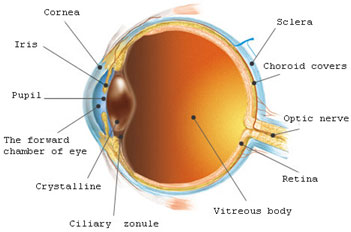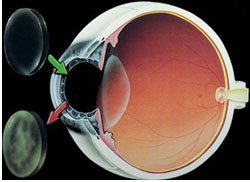| Cornea Transplant

The Cornea Transplant is the transparent portion of the eye which allows light to enter and performs two-thirds of the focusing tasks. The cornea also covers both the iris, the colored portion of the external eye, and the pupil, the reactive 'light meter' in front of the lens. There are no blood vessels in the cornea, but there are several nerves. Nutrients for the cornea are supplied by the same source as the tear ducts and internal vitreous fluids.
The cornea is often compared to the lens of a camera, but this can lead to a bit of confusion. The cornea does indeed allow light to enter the eyeball, and the cornea's convex shape focuses that light towards the pupil and another structure called the lens.
In essence, the cornea performs the broad brushstrokes of vision, while the shape-shifting lens performs the fine details before all of the light hits the retina. It is the shape of the cornea's dome which determines whether or not a person may be nearsighted, farsighted or astigmatic.
 During vision correction procedures, external lenses may be used to refocus images in the eye's lens or the shape of the cornea may be modified. Contact lenses placed directly on the cornea change its thickness, creating a new focal point. Some advanced contact lenses use tension to reshape the entire cornea, allowing near-normal vision until the cornea resumes its original shape and the blurriness returns Advanced surgical procedures such as Lasik make tiny incisions on the cornea which should create a new degree of curvature as they heal. Topical anesthetics numb the nerves leading to the cornea and the procedure is virtually bloodless. Occasionally the cornea may become scratched by external objects or a stray eyelash under the eyelid. During vision correction procedures, external lenses may be used to refocus images in the eye's lens or the shape of the cornea may be modified. Contact lenses placed directly on the cornea change its thickness, creating a new focal point. Some advanced contact lenses use tension to reshape the entire cornea, allowing near-normal vision until the cornea resumes its original shape and the blurriness returns Advanced surgical procedures such as Lasik make tiny incisions on the cornea which should create a new degree of curvature as they heal. Topical anesthetics numb the nerves leading to the cornea and the procedure is virtually bloodless. Occasionally the cornea may become scratched by external objects or a stray eyelash under the eyelid.
Removing the debris may be a simple matter of applying an approved eyewash or eye drops, but it often takes a few days for the cornea to heal from scratches.
Some people may develop serious medical conditions involving the cornea, including corneal cancer and ulcerations. Because the cornea does not contain blood, the tissue is remarkably resistant to rejection. This has led to the development of corneal transplant surgeries. Many organ donors list the cornea as one of their harvestable tissues after death. Unlike other organs and tissues, healthy corneal tissue is almost always compatible with patients waiting to receive it.
|